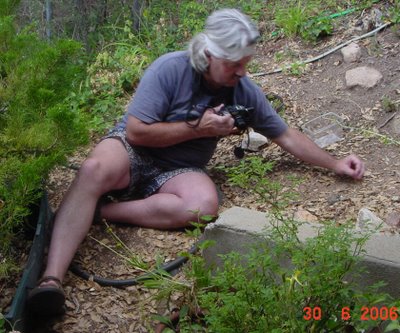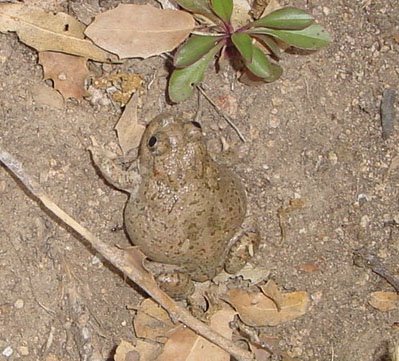And so the adventure begins.

When we get home, out comes a proper container for the odd small vertebrate or interesting insect. (SSon is an ecologist, professionally, with the Park Service. He comes equipped.)
It turns out that the critter is a spadefoot toad. Not necessarily rare, but rarely seen, says SS, adding that in nearly 30 years in the Arizona outback, he's never happened across one.
Reason being, spadefoots normally hide underground most of the year. "During summer monsoons, the spadefoot is well-known for emerging from its subterranean estivation to breed in the temporary ponds created by the heavy runoff. Interestingly, the cue for adult emergence during these summer thunderstorms is not moisture, but rather low frequency sound or vibration, most likely caused by rainfall or thunder.
"Upon emergence, males begin calling to attract females. Their calls sound like the bleating of sheep or goats. One female may lay as many as 3000 eggs. Once the eggs are laid, they must hatch quickly into tadpoles before these shallow pools disappear. And hatch quickly they do—at water temperatures of 86°F (30°C) eggs hatch in 15 hours! Tadpoles must also metamorphose quickly—2 weeks on average, sometimes as little as 9 days—into froglets before the ponds dry up. In this exacting atmosphere very few eggs make it to young frogs." All this according to the Desert Sonoran Museum.
 Of course, it is time for a series of proper pictures in a less confined space. Once Free! Whee! the toad begins, first, to hop away, then to use his spurred hind feet to dig right into the pathway.
Of course, it is time for a series of proper pictures in a less confined space. Once Free! Whee! the toad begins, first, to hop away, then to use his spurred hind feet to dig right into the pathway.
While I don't come equipped with a hot new professional digital camera, I do get this shot of our toad in a proper natural background. I'm reasonably pleased!
 Finally, it is time to release our captive. We pick the creek area at the back of Prescott College's Crossroads Center.
Finally, it is time to release our captive. We pick the creek area at the back of Prescott College's Crossroads Center.And wash our hands thoroughly. The spadefoot releases a toxic substance through his skin. If he had been the Colorado River toad and we were folks with an interest in far out visions, we might have licked our fingers, instead.
Later: for accuracy's sake, the commentary on toads above refers to Couch's spadefoot toad, which is a desert species; our mountain amphibian is, says Sson, a Hammond's spadefoot.
This little exercise in research has taught me a lesson or two about Google. 1st -- there were far more entries about toad licking than about the spadefoot toad. 2nd, there was no reference to the Hammond's version. 3rd, Firefly Forest is not Googled -- and it had a neat little reference to the spadefoot toad.





3 comments:
I remember old timers talking about "frogs" raining down from above and at least half believing it as, everywhere, toads appeared immediately after the rains began. There was also some speculation that the eggs were drawn up with evaporating water and waited there in the clouds until rain brought them back to earth to hatch.
Thanks for telling us about the spadefoot toad, and for the excellent pictures. This is a great science lesson to share with my Grandchildren!
You should see the wonderful pic Sson got on his latest, newest, high-techist camera with zillions of pixels per pic -- he zoomed in on the eyeball -- and you could see a reflection of him (the photographer) in it!!! BTW, my pigs are back & I discovered 3 more wallowing spots!
Have you found any Colorado River Toads?
Post a Comment